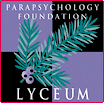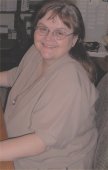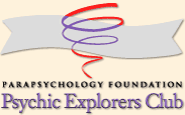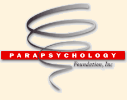 |
 |
| Nancy L. Zingrone  I used to tell people I became interested in the field in my teens because of the experiences of my close group of girlfriends and the amazingly good collection of scientific parapsychology in my hometown public library. Certainly, between us, there were a couple of precognitive dreams, some apparitional sightings, some semi-wild experiences with an Ouija Board, and a few family tales of odd occurrences. But now that I think about it there were other influences too: the old black and white television show from the 1950s and early 1960s, One Step Beyond — which always seemed to be referencing the work of J. B. Rhine; what seemed to be psychic experiences in such books as Jane Eyre and Wuthering Heights; and, of course, the pulp science fiction monthlies like Astounding Stories. So I knew who J. B. Rhine was when I ventured into the Woodstock Public Library in the mid-1960s, looking for books on “real” parapsychology. Luckily for me, the shelves included a slew of books on the scientific side of the field from Sudre’s Treatise on Parapsychology to virtually everything then available by the Rhines and Gaither Pratt, including Extrasensory Perception after Sixty Years. I used to tell people I became interested in the field in my teens because of the experiences of my close group of girlfriends and the amazingly good collection of scientific parapsychology in my hometown public library. Certainly, between us, there were a couple of precognitive dreams, some apparitional sightings, some semi-wild experiences with an Ouija Board, and a few family tales of odd occurrences. But now that I think about it there were other influences too: the old black and white television show from the 1950s and early 1960s, One Step Beyond — which always seemed to be referencing the work of J. B. Rhine; what seemed to be psychic experiences in such books as Jane Eyre and Wuthering Heights; and, of course, the pulp science fiction monthlies like Astounding Stories. So I knew who J. B. Rhine was when I ventured into the Woodstock Public Library in the mid-1960s, looking for books on “real” parapsychology. Luckily for me, the shelves included a slew of books on the scientific side of the field from Sudre’s Treatise on Parapsychology to virtually everything then available by the Rhines and Gaither Pratt, including Extrasensory Perception after Sixty Years.
But psychic phenomena was not my primary interest growing up: as long as I could remember I had planned to be a writer. When I went off to college my ambition was to get an English degree, then get a masters in journalism, and write for magazines or newspapers or both. But 1969 and 1970 were pretty heady years and real life took its toll. By my somewhat delayed sophomore year I was in college number three (Mundelein College in Chicago), signing up for an introductory course in parapsychology proposed by a young instructor who hadn’t quite finished his own PhD. Taught over the brief summer semester, John Bisaha’s course did the trick: I rediscovered my interest in the field and changed my major to psychology. The PEAR Lab’s Brenda Dunne was an undergraduate colleague of mine, and she and John did some interesting research together after I graduated in 1974. I headed off to get an MSEd in 1976 after a stint in my family’s business (the first of many), finished the degree in 1977 as the teaching market collapsed, and found myself back at Mundelein working in the Registrar’s Office. The high point that year was getting loaned out to the very creative Director of Development to help staff a month-long celebration of parapsychology built around the presence of the Smithsonian’s Psi Search exhibit in Mundelein’s library. In the aftermath of that experience, a group of us founded the Midwest Psi Research Institute, I submitted my first papers to a Parapsychological Convention (rightfully rejected, something that hasn’t happened since, thank heavens). Then Brenda left for Princeton to manage the PEAR Lab, John left the field altogether, and I threw myself into teaching parapsychology “on the side” — for credit at Northeastern Illinois University, and for the adult education market at Mundelein, Loop College, and the Field Museum of Natural History. My “day jobs” during the period were a couple of clerical positions at Chicago City-Wide College after another stint in the family business. In late 1982 after a lot more real life intervened, I found myself at the Institute for Parapsychology (now the Rhine Research Center), alternating between painting my new hole-in-the-wall office and figuring out what to do with the intellectual independence the Institute represented. It was a turning point. Through the field, I have met most of the people who have turned out to be my life-long friends and close colleagues, among them, my husband, Carlos S. Alvarado. I conducted experiments, got to understand the terrain of the field a little better, and then, fairly quickly, was confronted with the fiscal realities. My initial employment at the Rhine was for a three-year research fellowship that carried a miniscule salary but provided exceedingly valuable opportunities for research and teaching. As my tenure as a Fellow was ending, I turned down full-time jobs with Ian Stevenson at the University of Virginia where Carlos was winding up a four-year Research Assistantship, and with Chuck Honorton at the then-Psychophysical Research Laboratory. By then Carlos and I had a plan: to do PhDs in the history of science together at Duke University, get history jobs, and do research on the histories of psychology, psychical research, and parapsychology. During Duke and after Duke (from 1986 to 1993), Carlos and I supported ourselves by working at the “odd jobs” under- and unemployed academics and grad students tend to take, for example: selling articles to semi-popular magazines like the Parapsychology Foundation’s Parapsychology Review and working in cataloging at the university library (which he did); or scan-typing, copy-editing, doing billing, collections, page composition, and indexing for a couple of local publishers, and providing secretarial support to a Duke research unit that focused on land-use history (which I did); or writing small grant proposals and doing odd bibliographical jobs for a military historian (which we both did). All of the “odd jobs” were designed to keep us in school and to allow us the freedom to stay connected to the Institute and the field of parapsychology. The added benefit of that particular “odd job” phase was that every single experience contributed something useful to our current careers, whether it was learning publishing skills, how to coordinate courses and seminars, how to root around in print and on-line libraries, or to view methodologies from a variety of disciplinary perspectives. That the bills were paid was an added bonus. Sometime after I obtained doctoral candidacy I withdrew from Duke (Carlos had already finished his masters and withdrawn). We left Durham, putting our stuff in storage and heading off to Edinburgh to do our PhDs in psychology with Koestler Professor Robert L. Morris. Generous large grants for both of us from the Institut für Grenzegebiete der Psychologie und Psychohygiene (IGPP) in Freiburg, and a number of smaller grants from the Society for Psychical Research (SPR), the Perrott-Warrick fund, and the Parapsychology Foundation (PF) allowed us to take advantage of the opportunity. (Carlos obtained his PhD from Edinburgh in 1997, and I have recently completed the requirements for mine.) We spent the better part of the first two years in Edinburgh living in the Morrises’ “Granny Flat” which hosted many post-grads and working parapsychologists both before and after our tenure there. From 1995 to 2000, we alternated between living in/visiting Edinburgh and living in Puerto Rico where we ran a tiny independent research institute, Centro Estudios Integrales de Puerto Rico (CEIPR), and our on-the-side teeny-tiny publishing house, Puente Publications. More IGPP funds, small grants from the usual sources, editing and page composition contracts, and a very frugal standard of living allowed us to keep our “enterprise” going. We learned how to do research on a shoestring but we also found out first-hand that, unlike the UK, psychology departments in the US and Puerto Rico very rarely if ever consider hiring individuals for full-time positions if their resumes are chock-full of parapsychology. One of our page composition jobs in Puerto Rico was for the Parapsychology Foundation, helping Lisette Coly resurrect the Foundation’s publications program. After two years, in 2000, we accepted full-time on-site positions with the PF, and moved up to New York City that summer. Three years later, we and the PF’s “virtual” programs and publications office moved to Charlottesville, Virginia. A few months after we arrived, we were appointed to “volunteer” faculty positions at the Division of Perceptual Studies in the Department of Psychiatric Medicine at the University of Virginia. And here we still are. Over the course of my career, I have veered off the safe and conventional path any number of times so as to stay in the field. For most people, this is not a life they can choose because of family commitments and other responsibilities. Even for us, there have been many times when we thought circumstances were going to force us out of the field. But we could usually scale back our lifestyle, live like graduate students, or take on some new academic “odd job” to tide us over. We are both committed to the same goal: to remain active in the Parapsychological Association (PA) (which we have done until recently), to continue to conduct research, and to continue to expand our contributions to the scientific literature of the field, and to psychology. Like other collegial couples we read about in our history of science classes at Duke, we have been able to do more, endure more and enjoy it more than any two people alone. I don’t think of myself as one of the “big guys” in the field, but when I look back on my years of service to the PA, and the small but — I think — interesting body of work to which my name is attached, I feel satisified with what I’ve accomplished so far. It is even more obvious to me now than it was when I took John Bisaha’s class, that parapsychology deals with real anomalies. The phenomena we study are too readily dismissed by the wider scientific community without even an investigative glance given the prevalence and meaningfulness of seemingly paranormal experiences in the lives of the people who report them, and given the experimental evidence that exists. The social barriers we face can become ostracization, although usually they are only hostility or derision. It's painful to face that sometimes, but the job we do is too important and done by too few individuals world-wide to allow social prejudices to prevail. I believe that the work we do will, at the very least, broaden and deepen our understanding of personality, perception and social dynamics, not to mention the implications of our phenomena for physics, engineering, philosophy and other disciplines. That our mainstream colleagues, especially in the US, dismiss even the most conventionally-defined research in our canon without so much as a moment’s familiarity with it is short-sighted in the extreme. But it is a reality that the social barriers we face can’t easily be moved aside. So, my best advice to those of you who wish to brave these waters is basically the same as J. B. Rhine’s was to me in a letter in 1972: that is, get a conventional graduate degree in an area of research that is related to the scientific questions parapsychology poses and wait until after tenure to come “out.” If you’re like me — the kind of person that can’t delay gratification that long — you won’t follow that advice. (I framed Rhine’s letter, but I ignored his advice.) In that case: do the best you can to “be” in the field, both by preparing yourself for some career that will pay the bills and by making sure you read, experiment, publish, present, and support the societies and associations dedicated to the field when and where you can. In addition, do not fail to be respectful of experiencers and adepts. My own understanding was enriched recently when I had the good fortune to spend a long time talking to some very interesting women who are making their livings as psychics and mediums. So seek out the laboratories, the libraries, the centers of education, the practitioners, and if you can’t get paid employment in parapsychology, volunteer. The beauty of the field — and its present curse — is that we are still at the early stages of understanding the phenomena, so there is a lot to do from all perspectives. It is pretty hard sometimes to stick to a cohesive research plan, although the most productive careers out there have done that. (My own interests have wandered over the years from heavily experimental to historical to sociological to social psychological and back again.) And be satisfied with lesser contributions: not having my own laboratory — my original dream — just doesn’t seem all that important anymore. The path I’ve been on has just been too personally, socially, and intellectually satisfying to worry about how far off course it has veered on occasion. It’s the journey, after all, that really matters. Alvarado, C. S., & Zingrone, N. L. (2004). Experiencias parapsicológicas, absorción y sueños: Un estudio con estudiantes de psicología de Puerto Rico [In Spanish: Parapsychological experiences, absorption and dreams: A study with psychology students from Puerto Rico]. In F.E. da Silva (Ed.), II Encontro Psi: Refletindo sobre o futuro da parapsicologia [II Psi Encounter: Reflections on the future of parapsychology] (pp. 82–91). Curitiba, Brazil: Campus Universitario Bezerra de Menezes, Faculdades Integradas “Espírita.” Alvarado, C. S., & Zingrone, N. L. (2003). Exploring the factors related to the after-effects of out-of-body experiences. Journal of the Society for Psychical Research, 67, 161–183. Alvarado, C. S., & Zingrone, N. L. (1999). Out-of-body experiences among readers of a Spanish New Age magazine. Journal of the Society for Psychical Research, 63, 65–85. Alvarado, C. S., & Zingrone, N. L. (1998-1999). A study of the features of out-of-body experiences in relation to Sylvan Muldoon’s claims. European Journal of Parapsychology, 14, 89–99. Alvarado, C. S., & Zingrone, N. L. (1998). Anomalías de interacción con el ambiente: El estudio de los fenómenos parapsicológicos [In Spanish: Anomalies of interaction with the environment: The study of parapsychological phenomena]. Revista Puertorriqueña de Psicología, 11, 99–147. Alvarado, C. S., & Zingrone, N. L. (1998). La experiencia fuera del cuerpo y su influencia sobre actitudes y creencias: El impacto de la complejidad fenomenológica de la experiencia [In Spanish: Out-of-body experiences and their influence on attitudes and beliefs: The impact of the phenomenological complexity of the experience]. In A. Parra (Ed.), Tercer Encuentro Psi 1998: Conciencia y psi como fronteras de exploración científica (pp. 6–13). Buenos Aires: Instituto de Psicología Paranormal. Alvarado, C. S., & Zingrone, N. L. (1997-1998). Factors related to the depth of near-death experiences: Testing the “embellishment over time” hypothesis. Imagination, Cognition and Personality, 17, 339–344. Alvarado, C. S., & Zingrone, N. L. (1997). Experiencias disociativas y sueños: Relación con frecuencia de recuerdo de sueños, sueños lûcidos y sueños vívidos [In Spanish: Dissociative experiences and dreams: Relationship with the frequency of dream recall, lucid dreams and vivid dreams]. Ciencias de la Conducta, 12, 17–43. Alvarado, C. S., & Zingrone, N. L. (1997). Out-of-body experiences and sensations of “shock” to the body. Journal of the Society for Psychical Research, 61, 304–313. Alvarado, C. S., & Zingrone, N. L. (1997). Relación entre la experiencia fuera del cuerpo y la absorción: Estudios con participantes Puertorriqueños y Norteamericanos [In Spanish: Relationship between out-of-body experiences and absorption: Studies with Puerto Rican and American participants]. Revista Argentina de Psicología Paranormal, 8, 249–261. Alvarado, C. S., & Zingrone, N. L. (1996). La parapsicologia y las tradiciones espiritistas y ocultistas: Ampliando el alcance del estudio de las experiences humanas [In Spanish: Parapsychology and spiritist and occultist traditions: Enlarging the scope of the study of human experiences]. In A. Parra (Ed.), Segundo Encuentro Psi 1996 (pp. 23–27). Buenos Aires: Instituto Argentino de Psicologia Paranormal. Alvarado, C. S., & Zingrone, N. L. (1995). Characteristics of hauntings with or without apparitions. An analysis of published cases. Journal of the Society for Psychical Research, 60, 385–397. Alvarado, C. S., & Zingrone, N. L. (1994). Individual differences in aura vision: Relationships to visual imagery and imaginative-fantasy experiences. European Journal of Parapsychology, 10, 1–30. Alvarado, C. S., & Zingrone, N. L. (1990). Apparizioni da infestazione: Un analisi di casi pubblicate. [In Italian: Haunting apparitions: An analysis of published cases.] Luce e Ombra, 90, 324–340. Alvarado, C. S., & Zingrone, N. L. (1989). William McDougall, Lamarckism, and psychical research. American Psychologist, 44, 446–447. Alvarado, C. S., & Zingrone, N. L. (1988). Los síntomas de la histeria: Observaciones clínicas durante el siglo 19. [In Spanish: The symptoms of hysteria: Clinical observations during the 19th century.] Archivo Latinoamericano de Historia de la Psicología y Ciencias Afines, 1, 11–21. Alvarado, C. S., Zingrone, N. L., & Dalton, K. S. (1998-1999). Out-of-body experiences: Alterations of consciousness and the five-factor model of personality. Imagination, Cognition and Personality, 18, 297–317. Weiner, D. H., & Zingrone, N. L. (1989). In the eye of the beholder: Further research on the “checker effect.” Journal of Parapsychology, 53, 203–231. Weiner, D. H., & Zingrone, N. L. (1986). The checker effect revisited. Journal of Parapsychology, 50, 85–121. Zingrone, N. L. (In press). Complicating the conversation: Rhetoric, substance and controversy in parapsychology. Journal of Parapsychology. Zingrone, N. L. (2002). Controversy and the problems of parapsychology. Journal of Parapsychology, 66, 3–30. Zingrone, N. L. (1994). The medium as image: Power, pathology and passivity in the writings of Cesare Lombroso and Frederic Marvin. In L. Coly, and J.D.S. McMahon (Eds.), Women and parapsychology: The proceedings of the 1991 Parapsychology Foundation conference (pp. 90–123). New York: Parapsychology Foundation. Zingrone, N. L. (1988). Authorship and gender in American parapsychology journals. Journal of Parapsychology, 52, 321–343. Zingrone, N. L., & Alvarado, C. S. (2001-2002). The Dissociative Experiences Scale-II: Descriptive statistics, factor analysis, and frequency of experiences. Imagination, Cognition and Personality, 21, 145–157. Zingrone, N. L., & Alvarado, C. S., (1987). Historical aspects of parapsychological terminology. Journal of Parapsychology, 51, 49–74. Zingrone, N. L., Alvarado, C. S., & Dalton, K. (1998-1999). Psi experiences and the “Big Five”: Relating the NEO-PI-R to the experience claims of experimental subjects. European Journal of Parapsychology, 14, 31–51. Zingrone, N. L., Alvarado, C. S., Schlitz, M. J., & Milton, J. (Eds.) (1998). Research in parapsychology 1993. Lanham, MD: Scarecrow Press. |
 |

|
 www. parapsychology. org |
||